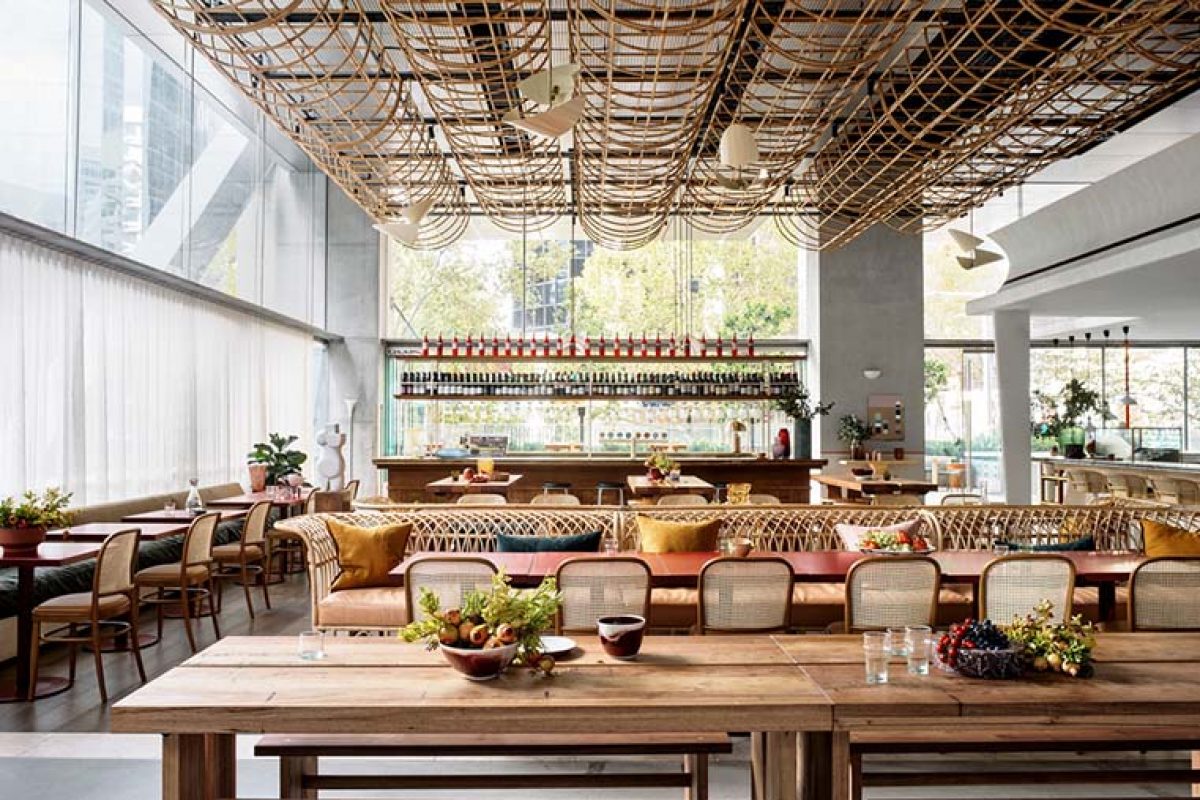Glorietta by Alexander & CO., the transformation of a voluminous glass box to a warm restaurant

Sydney-based architecture studio Alexander & CO. carried out the project to transform a stark, voluminous, glass box within a new landmark tower to a warm 220 seat regional Italian inspired restaurant. The studio explains the project development,
Inspired by the client's love of all things Italian, Glorietta is a bar and 220-seat restaurant designed to shape a corporate precinct into a Eurocentric agricultural memory.
As the podium tenant, Glorietta presented various key constraints. A cold and commercial character, including an open ceiling to allow for the base build utilities to remain effective and compliant. These obstacles made our teamwork to craft a sense of identity, intimacy, and warmth. Main dining area with rattan ceilings
Main dining area with rattan ceilings
Brief, Design Solution and Challenges
The owner had ambitious plans for a new Italian inspired Sydney restaurant and bar: it must be a catalyst for change, inspiring hospitality offerings into a corporate area previously lacking any. Contemporary yet classic, it must be a ‘come for a drink, stay for a meal kinda place’ and create a warm agricultural ancestry and tone, all within the building's pre-established constraints.
The client was keen to deconstruct the vast, open, and commercial space into separate, more intimate zones to encourage various functionalities and dining options. A key challenge presented itself in the form of the space being void of any existing character; to counterbalance this, zoning was achieved by applying a range of floor treatments to contain each space. Kitchen and Arbour
Kitchen and Arbour  Kitchen to the side and Family Table at rear
Kitchen to the side and Family Table at rear
From polished concrete around the bar and northern dining areas to timber boards in the central dining space and concrete slabs surrounding the kitchen, each variation in materials helped to distinguish the separate zones - as well as build personality and interest. The large scale, volume, view, and elevated floor area also became advantages to creating theatre and spatial uniqueness throughout the venue.
In support of this, the clever use of five different seating options further established each zone. From the high timber tables and stools at the bar, long communal tables and the built-in olive-green leather banquettes, rust-red-toned tables, and individual bentwood chairs. Varied seating options offer intimacy and choice depending on patrons dining and drinking needs.
A visible, traditional pizza oven and open kitchen capture the energy of a classic Italian restaurant and the theatrics that accompany this. A dining counter and bar ribbon the entry - which not only frames the entry but adds to the atmosphere and visual intrigue. A central bar was strategically positioned for maximum street visibility and to contain the venue's footprint, scale, and proportion. Family Table Detail
Family Table Detail  Pizza Oven
Pizza Oven
An earthy, organic, and warm palette was achieved via the careful selection of contemporary, yet durable, furnishings and fittings. Tonally gentle design elements soften the space. Recycled timber, olive and apricot leathers and tiling, rust-red tables, brass, creams, and wheat-colored linen curtains encircle the venue, while a vaulted rattan ‘cloudscape’ obscures the impact of the silver ceiling panels and offers yet another layer of warmth and natural texture to the space.
Glorietta's narrative is one of soft agricultural nostalgia which seamlessly enhances the otherwise hard-edged commercial volume. The innovative transformation of Glorietta from an amorphous commercial venue, into an intimate restaurant now appeals to the afternoon spritz seekers, late-night dinners, and the casual pizza crowd.
Glorietta plays an important role in acting as a cultural reference point for the business precinct it resides in, encouraging other businesses into the area and further activating the surrounding locale. Side Bar
Side Bar  Olive Tree and table detail
Olive Tree and table detail
Innovation, Sustainability, and Beauty
Due to Glorietta's elevated position, civic scale, and commercial character, the buildings tenancy had no sympathetically inherent texture or softness, no history, and no context on which to draw the design concept from. Faced with a blank canvas and multiple challenges in building an inviting, friendly intimacy and warmth, the team set about crafting a design beneficial to patrons, floor staff, and the wider local community.
Sustainability played an important role too, materials were kept to a minimum, all-natural, designed for longevity, and sustainably harvested where possible. An ingenious, vaulted ‘cloud sky’ of woven rattan covers the majority of the ceiling, providing additional warmth and organic shape while enclosing the whole restaurant by lowering the room-scale and warming the lighting. Rattan is one of the fastest renewable tropical woods available and is manufactured in low-tech non-polluting facilities.
Within Glorietta, beauty and sustainability collide with the salvaging and application of materials. Reclaimed hardwoods feature as bar cladding, with old stone slabs salvaged by the builder used as kitchen surround flooring. In a final, decorative flourish, a round Art Deco-inspired family table with sentimental value was inserted as a corner feature.
In an innovative sense, Glorietta's story is a social one that highlights the effectiveness of combining clever interior design practices within a venue's surrounding context. Bar
Bar Oyster Bar
Oyster Bar
Project Information
Principal Architect: Jeremy Bull
Project Architect: Sophie Harris
Interior Design Team: Katie Snow
Project Address: Upper Ground Floor, 100 Mount St, North Sydney, NSW Australia.
Photographer Credit: Anson Smart
Photography Styling Credit: Claire Delmar
Project Size: 420sqm
Source: Alexander & CO. and v2com
Top Image: Main dining area with rattan ceilings
Visit the Alexander & CO. website
Read more news related Alexander & CO. published at Infurma
News Infurma:
Online Magazine of the International Habitat Portal. Design, Contract, Interior Design, Furniture, Lighting and Decoration
